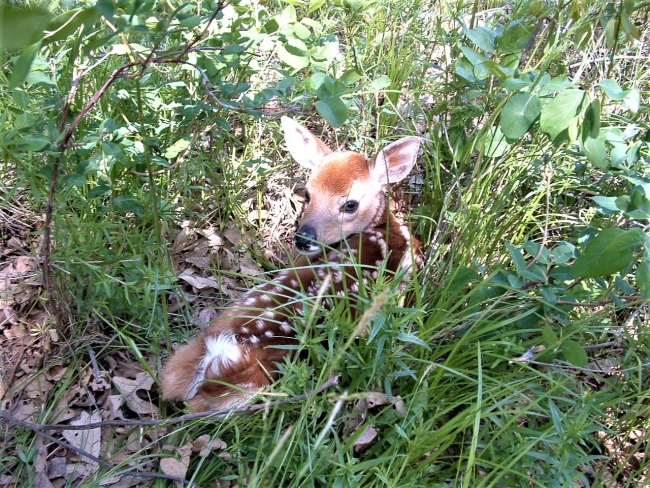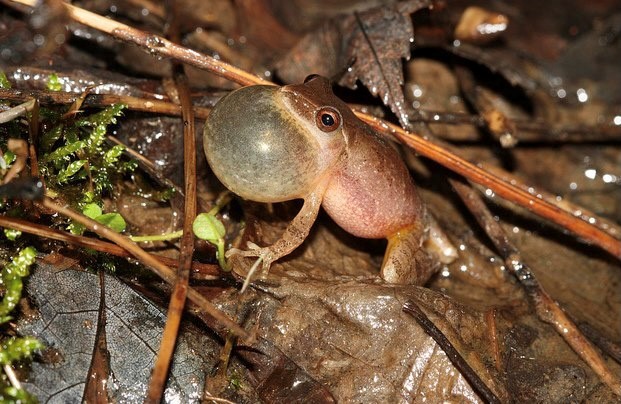Outdoor Delaware is the award-winning online magazine of the Delaware Department of Natural Resources and Environmental Control. Articles and multimedia content are produced by the DNREC Office of Communications.
This Mother’s Day, Outdoor Delaware is highlighting some of the state’s most fascinating animal parents, from the pouch-packing Virginia opossum to the solo-singing spring peeper. We talked to our biologists at the Delaware Department of Natural Resources and Environmental Control to get the scoop on a few local critters.
Virginia opossum
The Virginia opossum, sometimes mistakenly referred to as a possum (that’s a separate species that lives in Australia), is Delaware’s only native marsupial. In fact, it’s the sole marsupial found in the wild in the United States.

Like all marsupials, the Virginia opossum gives birth to undeveloped young — little more than an embryo, according to Hunter Slear, the DNREC Division of Fish and Wildlife’s furbearer biologist. A litter can range from about five to 13 babies, although seven or eight is typical. The species’ gestational period of roughly two weeks is among the shortest in the animal kingdom (humans have one of the longest pregnancies, although this pales in comparison to the approximately 20 months an elephant is pregnant).
At birth, joeys, as young opossums are called, are blind, hairless and roughly the size of your fingernail. After being born, the babies will scamper into their mother’s belly pouch, where they’ll spend the next two months, relying on the mother’s mammary glands for food.
After growing rapidly, the young open their eyes for the first time at around eight weeks of age. They’ll exit their mother’s pouch but will remain with her for another month or two and can frequently be seen sitting on her back. At three or four months, the young opossums will have been weaned off their mother’s milk and then set off on their own.
“Out of the furbearers, I definitely think that they’re one that take exceptional care of their young,” Slear said.
Beaver
You may not have ever seen one, but Delaware is home to beavers, which reside near bodies of freshwater. The largest rodent in North America, beavers typically give birth to four or five young, although they can have up to eight.
The North American beaver will build its famous wooden lodges in and around water and give birth to its kits there after about four months of pregnancy. In contrast to many species, young beavers continue to stay with their mothers beyond the first few months of their lives.
“Unlike foxes that are born in the spring and kicked out that fall so they’re on their own, beavers will usually stay within their family for an extra year. Generally, at 2 years of age is when the beaver young moves out and then finds its own mate and establishes its own area,” Slear said.
A young beaver will rely on its mother’s milk for the first few weeks of its life before learning to eat bark, leaves, twigs and aquatic plants.
White-tailed deer
Like most mammals, young deer are raised solely by the females of the species. Males contribute their genetic material but otherwise don’t really play a role in their offspring’s lives.
The mating season for deer comes around November, with babies being born in May or June. A doe will typically only have one fawn the first time she is pregnant and two or even three babies at a time thereafter.

Before giving birth, a doe will find an isolated area to help keep her baby safe and ensure it bonds with her rather than other deer. When the fawn is born, the mother will lick it clean to ensure predators cannot detect the scent of blood that signals an easy target.
Baby deer can generally stand just minutes after being born, although their legs are wobbly.
A fawn will spend the first few weeks of its life largely resting in one spot amidst foliage while the mother ventures off to get food. Because of this, people will sometimes stumble across a baby deer in the wild and, not seeing any adults nearby, believe it has been abandoned. This, according to DNREC Division of Fish and Wildlife deer biologist Sam Millman, is a misconception.
The mother knows where her fawn rests and typically is not very far away, although a fawn will remain in its spot until its parent comes to fetch it. Anyone who spots a baby deer in the wild should let it be, even if it appears to be on its own, Millman emphasized.
While female deer form family units – think generations of deer in one herd – the young will usually be temporarily pushed away in the fall when it’s time to mate again.
Spring peeper
These tiny frogs are only around an inch in size, but they are vocal! The high-pitched calls of the males of the species signal the arrival of spring in marshes around the state, such as at the Delaware National Estuarine Research Reserve’s Blackbird Creek Reserve in Townsend. Their calls are repeated about 20 times per minute. The faster and louder they sing, the greater the chances of finding a mate.

Females lay around 900 eggs in freshwater pools, ponds and other wetlands where fish are not present. These eggs attach to underwater vegetation and are fertilized by males as they are laid. Depending on the temperature, eggs can hatch within two days to two weeks.
The tadpoles have gills to breathe underwater and tails to help them swim. Over the course of six to 12 weeks, they will transform into fully independent frogs, although the vast majority of these will not survive long enough to reproduce.
Osprey
Ospreys, a species of raptor, are typically found in Delaware only during the spring and summer months, with many migrating north to the First State for breeding season. A male and female will work together to build a nest out of sticks, grass, bark and other items on a tree, cliff or utility pole near water.
Nests may start out small, but because ospreys often use the same nest year after year, they can grow over time as the birds add to it, eventually becoming large enough for an adult human to sit in. Ospreys will often build nests relatively close to where they were born.
Like beavers but unlike most species, ospreys are typically monogamous, although they will often find a new mate if their old one dies. A female usually lays two or three eggs in April or May and is largely responsible for watching over the eggs while the male brings her food. After about five or six weeks, the chicks hatch.
Once the chicks have emerged from their eggs, it takes roughly two months before the babies can fly. During the first eight or so weeks of their lives, the chicks rely on their parents, with the father bringing fish back to the nest for his young and his mate. Afterward, they’ll start catching fish on their own.
Toward the end of summer, the birds will set off on their own, migrating south ahead of the colder temperatures.
As you can see, each species has its own unique way of nurturing the next generation. So, this Mother’s Day, let’s take a moment to appreciate the remarkable mothers of the animal kingdom right here in Delaware – a list that, of course, includes all the humans celebrating the special day.
Related Topics: animals, fish and wildlife, mother's day, outdoor delaware, parenting